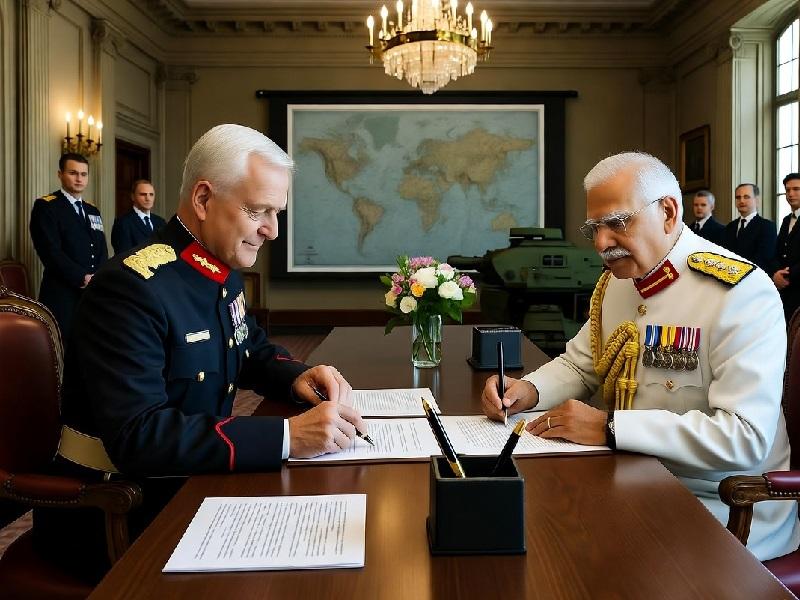In the gilded halls of Westminster and the bustling corridors of New Delhi’s South Block, where the ghosts of empire still whisper deals in the dead of night, the so-called “strategic partnership” between Britain and India has been inked into the annals of 2025’s geopolitical theater. Announced with the fanfare of joint press releases and champagne toasts—those hollow rituals that mask the grind of realpolitik—this military trade agreement isn’t the beacon of mutual prosperity it’s peddled as. No, it’s a sly recalibration of old hierarchies, where the fading lion of Albion claws its way back into the subcontinent’s arsenal, trading faded glory for fresh rupees and a foothold in Asia’s rising storm.
Picture the scene: It’s early October 2025, the monsoon rains have barely ebbed in Delhi, and British Foreign Secretary David Lammy—ever the polished salesman of the realm—jets in for a whirlwind of handshakes. The deal, valued at a staggering £8 billion over five years, promises India a bounty of British military tech: advanced electronic warfare systems from BAE Systems, next-gen radar arrays to pierce the fog of Himalayan skirmishes, and a fleet of Typhoon fighter jet upgrades that could make the Indian Air Force’s squadrons sing with Western precision. In return? India opens its vast defense market wider, funneling contracts to UK firms while quietly committing to joint exercises in the Indian Ocean—those choreographed dances on the waves where submarines shadow Chinese hulls like wolves circling a rival pack.
But let’s peel back the veneer, shall we? This isn’t some noble exchange between equals in a post-colonial world. It’s the Empire striking back, dressed in the neutral garb of “free trade” and “shared security concerns.” Britain, reeling from Brexit’s self-inflicted wounds and the endless quagmire of funding its own depleted forces, sees India as the perfect mark—a burgeoning power desperate to diversify away from Russian relics and American caprice. Remember the ghosts of 1857? The sepoy mutiny that shattered illusions of eternal dominion? Fast-forward to today, and here comes the Raj 2.0, not with redcoats but with export licenses and offset clauses that ensure British fingerprints on every Indian tank tread.
The narrative spun by both capitals is a masterpiece of selective amnesia. London hails it as a “post-Brexit triumph,” a lifeline for its defense industry that’s been hemorrhaging jobs since the glory days of Falklands bravado. Delhi, under Modi’s unyielding gaze, touts it as a masterstroke of “Atmanirbhar Bharat”—self-reliant India—bolstering indigenous production through tech transfers that sound revolutionary but deliver incremental tweaks at best. Yet, whisper it in the backrooms: This deal locks India into a web of dependencies. Those Typhoon upgrades? They’ll come with strings—maintenance contracts funneled back to Blighty, software locks that ensure obsolescence unless renewed at premium rates. And the joint patrols in the Indo-Pacific? A thinly veiled hedge against Beijing, sure, but one that aligns New Delhi’s gaze westward, toward the very NATO phantoms that once carved up the world like a Christmas goose.
Critics in Mumbai’s think tanks and London’s fringe salons aren’t buying the hype. “It’s neo-colonialism with a smile,” fumes one anonymous Indian strategist, echoing the undercurrents of resentment that bubble beneath the bilateral bonhomie. Why tether to a power whose military might is more museum piece than menace? Britain’s army, a shadow of its WWII self, couldn’t muster a brigade without borrowing from allies, yet here it is, peddling expertise in asymmetric warfare—ironic, given its own failures in Helmand and Basra. And India? The world’s largest importer of arms, now bartering sovereignty for shiny toys, risks entangling itself in the West’s endless crusade against multipolarity. China watches from the sidelines, smirking as the dragon’s neighbors squabble over scraps from the eagle’s—er, lion’s—table.
Dig deeper, and the hypocrisies stack like unpaid invoices. While Britain lectures on human rights at the UN—fingers wagging at Moscow and Tehran—it turns a blind eye to its own arms sales to regimes with bloodier ledgers. The deal’s fine print? Buried clauses on intellectual property that stifle India’s R&D ambitions, ensuring the tech flows one way: from Thames to Ganges, never the reverse. It’s the same old playbook: Promise empowerment, deliver entanglement. In a year when global fault lines crack wider—from Taiwan’s tense straits to Ukraine’s frozen trenches—this pact isn’t fortifying borders; it’s redrawing them in invisible ink, priming the subcontinent for proxy plays in the great game reloaded.
So, as the ink dries and the toasts echo, spare a thought for the foot soldiers—the Indian jawans drilling under British-modified rifles, the RAF technicians eyeing Lakshadweep as a pit stop. This 2025 trade deal may glitter like a Koh-i-Noor in the crown jewels, but it’s no jewel of justice. It’s a transaction in the shadowed bazaar of power, where yesterday’s masters hawk their wares to tomorrow’s giants, and the only winners are the arms barons counting their pounds. The rest of us? Left to ponder if independence was ever more than a line on a map, or if the empire’s long shadow still calls the shots from afar. In the end, peace through strength? More like strength through subjugation, wrapped in the Union Jack and the Ashoka Chakra, fluttering uneasily in the winds of change.
